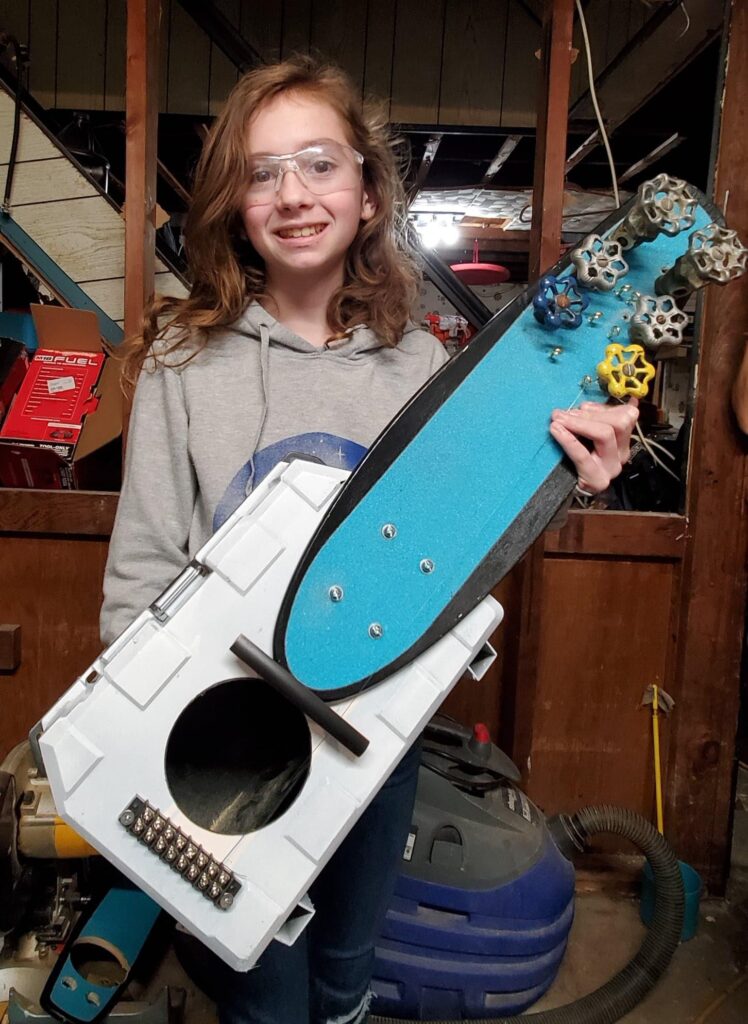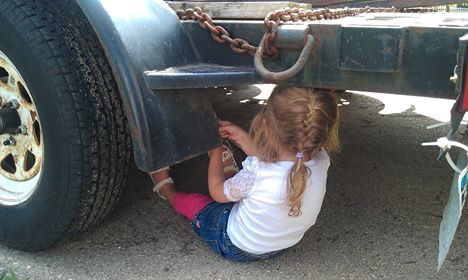
by T.J. Allcot
We are a family of makers. Even my wife, who isn’t as crafty as she’d like to be, creates worlds through words.
The maker-gene is strong in our kids. They love sticking cardboard boxes together with duct tape to create crazy sculptures, leprechaun traps, or entire villages. I’ve forbidden them from using the “good” duct tape like my rolls of Gorilla or T-Rex tape, which is okay because they seem to prefer the colorful, patterned tape you find at Michael’s or Target anyway.
Just a month ago, my daughter had a sixth grade-music project: Recycle household items into a musical instrument.
The project was combining creativity, sustainability, and ingenuity. Perfect. Best of all, my wife gave me a heads-up on the project a few weeks early so this wasn’t (completely) a last-minute rush job.
My daughter wanted to build a guitar out of recycled materials. She had a youth guitar that had been crushed a while ago. She envisioned salvaging the strings from that long-gone guitar for this project. I’m reasonably certain that she intended to craft the rest out of a cereal box and paper towel roll, as many kids would.
But I had other ideas.
The Right Tools for the Job
My daughter takes after me as far as “fiddling” with tools and building stuff. When she was two years old I found her “helping” me work on a trailer we used to haul our old Paintball tank to events. She had climbed under the trailer and was using her own pliers on the wiring. I have always tried to encourage this in her, whether it’s helping her work on her old battery-operated race car or helping me drill holes in a 2×8 with her toy drill.

This project was perfect to nurture my daughter’s nascent maker skills, give her some practice with real power tools, and cultivate creative thinking as we looked for “household objects” we could use to build a guitar.
We headed off to the basement, rummaged around in two separate piles of stuff looking for leftover plumbing parts and found six water valves still attached to lengths of copper pipe. These were left over from when I moved the washing machine. The general rule is you do not reuse plumbing fittings. So, I should have thrown them out. But around here, you just never know what you’re going to need, which means there are all sorts of odds and ends scattered around.
The discovery of the plumbing fittings gave me a good excuse to get my daughter a bit more Sawzall time. I had started showing her the basics of using one of my battery operated Sawzalls months ago and now it was time to expand on that. I told her to get her safety glasses.
Off to the wilds of the backyard: I set up the portable clamp, prepped the Sawzall and walked my daughter through cutting a valve off of a section of pipe. I finished the other five.
Don’t Be Afraid to Fail
Rummaging around in the garage next, I discovered a stack of skateboard decks – the forlorn remains that weren’t used for a Ninja Warrior project — stuffed up on a shelf in the garage, collecting dust for years. Out of the five I found, we destroyed two by drilling a lot of holes in them before we got a third done to a satisfactory state.
Chalk up another achievement for my daughter as I reaffirmed that the Milwaukee M12 drill belongs to her and her brother and that she can use my heavier Milwaukee M18 drill when she needs something with a bit more power. I did most of the guesswork as to where stuff was being drilled (which is why it took three skateboard decks). Sometimes it’s just easier to plow ahead until you get right. Try, test, fail, try again. It works for SpaceX.
I marked a bunch of dots on the skateboard deck with a Sharpie and she drilled out the majority of the holes needed. I pulled an old DeWalt toolbox from one of my dead orbital sanders, set her up with a respirator out in the garage and she spray-painted the box white.
Back inside to our temporary workspace in the basement, where I set up a 4” hole saw for her and let her drill the sound hole. We used an old wiring terminal strip that had once been intended for some robotics project, the handle from a kitchen drawer to finish off what I knew of necessary guitar components. I got the placement slightly wrong, as family members who are actually guitarists pointed out, but it worked well enough.
Document Your Process
This was an odd enough project that I had videoed my daughter
as she worked on various parts of her recycled guitar. I copied the best clips
over to a flash drive. She brought it in to school to show the teacher if he
asked what she did. He liked the video clips so much that he showed them to her
entire class on the digital whiteboard.
And there it was: A guitar made from random reclaimed parts and a weekend’s
worth of life lessons for my daughter about how to think like a maker, use what
you have to get the job done, and look beyond the obvious when you’re drawing
up designs or sourcing components.
Recommended Reading:






